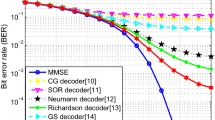Abstract
In massive multiple-input multiple-output (MIMO) systems when the number of base station antennas is much higher than the number of users, linear detectors, such as zero forcing (ZF) and minimum mean-square error (MMSE), are able to achieve the near-optimal performance due to the favorable massive MIMO channel propagation. But, these detectors employ, in general, exact matrix inversion which is computationally complex for such systems. In this paper, we affirm that computing the exact matrix inversion by direct methods is not necessary to find ZF or MMSE solution. An iterative matrix inversion procedure would yield similar performance. Thus, an efficient iterative matrix inversion based on the hyper-power (HP) method is proposed for massive MIMO detection. The computing efficiency of the iterative matrix inversion is further improved by optimizing the number of terms from the infinite series used in the HP method. Analytical results show that the optimum choice for the number of terms is three from the HP method. Simulation results show that the HP method with the optimum number of terms achieves the near-optimal ZF performance in a small number of iterations. Finally, the Coppersmith–Winograd algorithm for matrix multiplication is employed in order to reduce the computational complexity from \(O(K^{3})\) to \(O(K^{2.373})\), where K represents the number of users.







Similar content being viewed by others
References
Rusek, F., Persson, D., Lau, B. K., Larsson, E. G., Marzetta, T. L., Edfors, O., et al. (2013). Scaling up MIMO: Opportunities and challenges with very large arrays. IEEE Signal Processing Magazine, 30(1), 40.
Minango, J., Altamirano, C. D., & de Almeida, C. (2018). Performance difference between zero-forcing and maximum likelihood detectors in massive MIMO systems. Electronics Letters, 54(25), 1464. https://doi.org/10.1049/el.2018.6507.
Bai, D., Park, C., Lee, J., Nguyen, H., Singh, J., Gupta, A., et al. (2012). LTE-advanced modem design: Challenges and perspectives. IEEE Communications Magazine, 50(2), 178.
Hoydis, J., ten Brink, S., & Debbah, M. (2013). Massive MIMO in the UL/DL of cellular networks: How many antennas do we need? IEEE Journal on Selected Areas in Communications, 31(2), 160.
Press, H., Teukolsky, A., Vetterling, T., & Flannery, P. (2007). Numerical recipes: The art of scientific computing (3rd ed.). Cambridge: Cambridge University Press.
Higham, N. (2008). Functions of matrices: Theory and computation (1st ed.). Philadelphia: SIAM.
Barrett, R., Berry, M., Chan, T. F., Demmel, J., Donato, J., Dongarra, J., et al. (1994). Templates for the solution of linear systems: Building blocks for iterative methods (2nd ed.). Philadelphia: SIAM.
Minango, J., de Almeida, C., & Altamirano, C. Daniel . (2017). Low-complexity MMSE detector for massive MIMO systems based on Damped Jacobi method. In IEEE 28th annual international symposium on personal, indoor, and mobile radio communications (PIMRC) (pp. 1–5). https://doi.org/10.1109/PIMRC.2017.8292627.
Dai, L., Gao, X., Su, X., Han, S., C.L, I., & Wang, Z. (2015). Low-complexity soft-output signal detection based on Gauss–Seidel method for uplink multiuser large-scale MIMO systems. IEEE Transactions on Vehicular Technology, 64(10), 4839.
Minango, J., & de Almeida, C. (2017). Low-complexity MMSE detector based on refinement Gauss-Seidel method for massive MIMO systems. In IEEE 9th Latin-American conference on communications (LATINCOM) (pp. 1–5). https://doi.org/10.1109/LATINCOM.2017.8240166.
Wu, M., Yin, B., Wang, G., Dick, C., Cavallaro, J. R., & Studer, C. (2014). Large-scale MIMO detection for 3GPP LTE: Algorithms and FPGA implementations. IEEE Journal of Selected Topics in Signal Processing, 8(5), 916.
Minango, J., & de Almeida, C. (2017). Low-complexity MMSE detector based on the first-order Neumann series expansion for massive MIMO systems. In IEEE 9th Latin-American conference on communications (LATINCOM) (pp. 1–5). https://doi.org/10.1109/LATINCOM.2017.8240164.
Wang, Y., & Leib, H. (2013). Sphere decoding for MIMO systems with newton iterative matrix inversion. IEEE Communications Letters, 17(2), 389.
Minango, J., & de Almeida, C. (2018). Low complexity zero forcing detector based on Newton–Schultz iterative algorithm for massive MIMO systems. IEEE Transactions on Vehicular Technology, 67(12), 11759. https://doi.org/10.1109/TVT.2018.2874811.
Ben-Israel, A. (1965). An iterative method to computing the generalized inverse of an arbitrary matrix. Mathematics of Computation, 19, 452.
Tse, D., & Viswanath, P. (2005). Fundamentals of wireless communication. New York, NY: Cambridge University Press.
Ben-Israel, A., & Cohen, D. (1966). On iterative computation of generalized inverses and associated projections. Journal of the Society for Industrial and Applied Mathematics: Series B, Numerical Analysis Mathematics of Computation, 3, 410.
Prasad, K. N. R. S. V., Hossain, E., & Bhargava, V. K. (2017). Energy efficiency in massive MIMO-based 5G networks: Opportunities and challenges. IEEE Wireless Communications, 24(3), 86.
Edelman, A. (1988). Eigenvalues and condition numbers of random matrices. SIAM Journal on Matrix Analysis and Applications, 9(4), 543.
Acknowledgements
The authors thankful to SENESCYT-IFTH and CAPES for the financial support.
Funding
Funding was provided by Coordenação de Aperfeiçoamento de Pessoal de Nível Superior (Grant No. Bolsa Pesquisa), Secretaría de Educación Superior, Ciencia, Tecnología e Innovación (EC) (Grant No. Scholarship).
Author information
Authors and Affiliations
Corresponding author
Additional information
Publisher's Note
Springer Nature remains neutral with regard to jurisdictional claims in published maps and institutional affiliations.
Rights and permissions
About this article
Cite this article
Minango, J., de Almeida, C. Hyper-power zero forcing detector for massive MIMO systems. Wireless Netw 25, 4349–4357 (2019). https://doi.org/10.1007/s11276-019-02099-z
Published:
Issue Date:
DOI: https://doi.org/10.1007/s11276-019-02099-z




